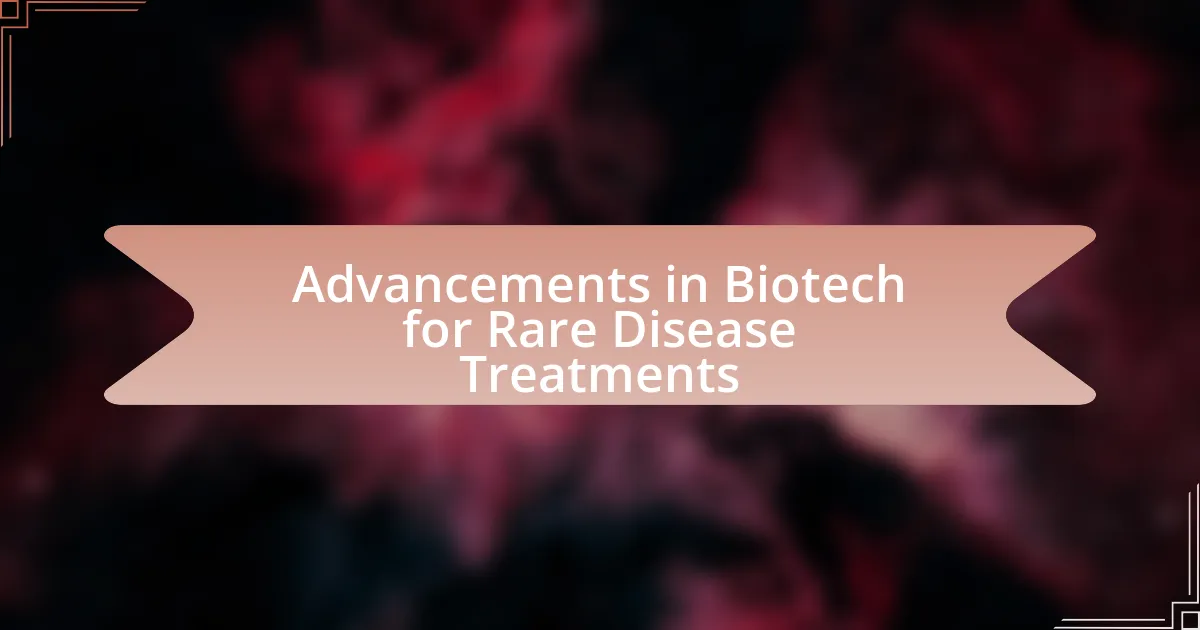The article focuses on recent advancements in biotechnology for treating rare diseases, highlighting significant developments such as gene therapies, CRISPR technology, and mRNA applications. It discusses how these innovations have transformed the landscape of rare disease therapies by enabling targeted and personalized medicine, improving treatment outcomes, and increasing the number of available therapies. The article also examines the role of genetic therapies in addressing the underlying causes of rare diseases, the impact of regulatory frameworks on treatment development, and the ethical considerations surrounding these advancements. Additionally, it explores future trends and the potential of emerging technologies to further enhance rare disease treatments.

What are the recent advancements in biotech for rare disease treatments?
Recent advancements in biotech for rare disease treatments include the development of gene therapies, which have shown significant promise in addressing genetic disorders. For instance, the FDA approved Zolgensma, a gene therapy for spinal muscular atrophy, which has demonstrated the ability to improve motor function in patients. Additionally, CRISPR technology has been utilized in clinical trials to edit genes responsible for conditions like sickle cell disease, with early results indicating potential for long-term remission. Furthermore, mRNA technology, initially popularized by COVID-19 vaccines, is being explored for rare diseases, with companies like Moderna and BioNTech investigating its application in treating genetic disorders. These advancements are supported by a growing body of research and clinical evidence, highlighting the transformative potential of biotech in rare disease management.
How have these advancements changed the landscape of rare disease therapies?
Advancements in biotechnology have significantly transformed the landscape of rare disease therapies by enabling the development of targeted treatments and personalized medicine. These innovations, such as gene therapy and CRISPR technology, allow for precise interventions at the genetic level, addressing the root causes of rare diseases rather than just managing symptoms. For instance, the approval of gene therapies like Zolgensma for spinal muscular atrophy has demonstrated the potential for curative outcomes, showcasing a shift from traditional approaches to more effective, individualized treatments. Additionally, the rise of orphan drug designations has incentivized pharmaceutical companies to invest in rare disease research, leading to a notable increase in the number of therapies available, with over 700 orphan drugs approved by the FDA as of 2021. This combination of technological advancements and regulatory support has fundamentally altered the treatment paradigm for rare diseases, improving patient outcomes and expanding access to innovative therapies.
What specific technologies are driving these advancements?
Gene editing technologies, particularly CRISPR-Cas9, are driving advancements in biotech for rare disease treatments. CRISPR-Cas9 allows precise modifications to DNA, enabling the correction of genetic mutations responsible for various rare diseases. Additionally, advancements in next-generation sequencing (NGS) facilitate rapid and accurate identification of genetic variants, which is crucial for developing targeted therapies. Furthermore, the use of artificial intelligence (AI) in drug discovery accelerates the identification of potential treatments by analyzing vast datasets to predict drug efficacy and safety. These technologies collectively enhance the ability to develop innovative therapies for rare diseases, as evidenced by the increasing number of gene therapies approved by regulatory agencies in recent years.
How do these technologies improve treatment outcomes for patients?
Advancements in biotech improve treatment outcomes for patients by enabling more precise and personalized therapies. These technologies, such as gene editing and targeted drug delivery systems, allow for the development of treatments that specifically address the underlying genetic causes of rare diseases. For instance, CRISPR technology has been shown to effectively correct genetic mutations in conditions like sickle cell disease, leading to significant improvements in patient health and quality of life. Additionally, biopharmaceuticals developed through biotechnology have demonstrated higher efficacy and fewer side effects compared to traditional treatments, as evidenced by the success of monoclonal antibodies in treating rare autoimmune disorders.
What role do genetic therapies play in these advancements?
Genetic therapies play a crucial role in advancements in biotech for rare disease treatments by enabling targeted interventions that address the underlying genetic causes of these conditions. These therapies, such as gene editing and gene replacement, allow for the correction of mutations or the introduction of functional genes, significantly improving patient outcomes. For instance, the approval of therapies like Zolgensma for spinal muscular atrophy demonstrates the effectiveness of genetic approaches in treating previously untreatable diseases, showcasing a shift towards precision medicine in rare disease management.
How do genetic therapies target the underlying causes of rare diseases?
Genetic therapies target the underlying causes of rare diseases by directly modifying or correcting the genetic mutations responsible for those conditions. These therapies utilize techniques such as gene replacement, gene editing, and RNA interference to address the specific genetic anomalies. For instance, in conditions like spinal muscular atrophy, the therapy Zolgensma delivers a functional copy of the SMN1 gene, effectively restoring the production of the SMN protein that is deficient in affected individuals. This targeted approach not only alleviates symptoms but also addresses the root cause of the disease, leading to more effective and potentially curative outcomes.
What are the success rates of genetic therapies in clinical trials?
The success rates of genetic therapies in clinical trials vary significantly depending on the specific condition being treated and the type of therapy used. For instance, a review published in 2021 indicated that the overall success rate for gene therapies targeting inherited retinal diseases was approximately 60%, while therapies for hemophilia showed success rates around 80%. Additionally, a meta-analysis of various gene therapy trials reported an average success rate of about 50% across different indications. These statistics highlight the promising yet variable efficacy of genetic therapies in clinical settings.
Why is personalized medicine important in the context of rare diseases?
Personalized medicine is crucial in the context of rare diseases because it tailors treatment strategies to the individual genetic and molecular profiles of patients, enhancing therapeutic efficacy. Rare diseases often have unique genetic mutations that standard treatments may not address effectively; therefore, personalized approaches can identify specific therapies that target these mutations. For instance, the use of gene therapy in conditions like spinal muscular atrophy has shown significant success, with a study published in the New England Journal of Medicine demonstrating a 47% increase in survival rates among treated infants compared to historical controls. This evidence underscores the importance of personalized medicine in optimizing outcomes for patients with rare diseases.
How does personalized medicine differ from traditional treatment approaches?
Personalized medicine differs from traditional treatment approaches by tailoring medical treatment to the individual characteristics of each patient, particularly their genetic makeup. Traditional treatment typically follows a one-size-fits-all model, where therapies are standardized based on population averages, often leading to variable effectiveness among patients. In contrast, personalized medicine utilizes genetic testing and biomarkers to identify the most effective treatments for specific individuals, enhancing treatment efficacy and minimizing adverse effects. For instance, targeted therapies in oncology, such as trastuzumab for HER2-positive breast cancer, exemplify how personalized medicine can improve outcomes by focusing on the unique genetic profile of the tumor.
What are the challenges in implementing personalized medicine for rare diseases?
The challenges in implementing personalized medicine for rare diseases include limited patient populations, high costs of development, and insufficient genetic and clinical data. Limited patient populations hinder clinical trials, making it difficult to gather statistically significant results. High costs arise from the need for specialized treatments and the lengthy research and development processes, which can exceed millions of dollars. Additionally, insufficient genetic and clinical data restricts the ability to identify effective biomarkers and tailor treatments, as many rare diseases lack comprehensive research. These factors collectively impede the advancement and accessibility of personalized medicine for rare diseases.
How do regulatory frameworks impact advancements in biotech for rare diseases?
Regulatory frameworks significantly influence advancements in biotech for rare diseases by establishing guidelines that ensure safety and efficacy while facilitating innovation. These frameworks, such as the Orphan Drug Act in the United States, provide incentives like tax credits and market exclusivity, which encourage companies to invest in the development of treatments for rare diseases. For instance, since the enactment of the Orphan Drug Act in 1983, over 700 orphan drugs have been approved, demonstrating how supportive regulations can lead to tangible advancements in treatment options for patients with rare conditions.
What are the key regulatory challenges faced by biotech companies?
Biotech companies face several key regulatory challenges, primarily including lengthy approval processes, stringent compliance requirements, and evolving regulatory frameworks. Lengthy approval processes can delay the introduction of innovative therapies, as seen in the average time of 10 to 15 years for drug development and approval by agencies like the FDA. Stringent compliance requirements necessitate extensive documentation and adherence to Good Manufacturing Practices (GMP), which can be resource-intensive. Additionally, evolving regulatory frameworks, such as those addressing gene editing and personalized medicine, create uncertainty and require companies to adapt quickly to new guidelines. These challenges can hinder the ability of biotech firms to bring rare disease treatments to market efficiently.
How can regulatory bodies facilitate faster access to treatments?
Regulatory bodies can facilitate faster access to treatments by implementing expedited review processes and adaptive licensing frameworks. These approaches allow for quicker evaluation of therapies, particularly for rare diseases, which often lack effective treatment options. For instance, the FDA’s Breakthrough Therapy designation accelerates the development and review of drugs that show promise in treating serious conditions, enabling patients to access potentially life-saving treatments sooner. Additionally, regulatory bodies can promote collaboration between stakeholders, including pharmaceutical companies and patient advocacy groups, to streamline the approval process and ensure that innovative therapies reach the market efficiently.

What are the implications of these advancements for patients and healthcare systems?
Advancements in biotech for rare disease treatments significantly improve patient outcomes and healthcare system efficiency. These innovations enable targeted therapies that can lead to better management of rare diseases, reducing the burden of symptoms and improving quality of life for patients. For instance, gene therapies have shown success in treating conditions like spinal muscular atrophy, resulting in a 50% reduction in mortality rates among treated patients. Additionally, these advancements can lower healthcare costs by decreasing the need for long-term care and hospitalizations, as effective treatments can lead to earlier interventions and better disease management. Consequently, healthcare systems can allocate resources more effectively, enhancing overall patient care and optimizing treatment pathways.
How do these advancements improve patient quality of life?
Advancements in biotech for rare disease treatments significantly improve patient quality of life by providing targeted therapies that address the specific genetic and molecular causes of these diseases. For instance, gene therapies can correct or replace defective genes, leading to improved health outcomes and reduced symptoms. A study published in the New England Journal of Medicine demonstrated that patients with spinal muscular atrophy experienced a 50% increase in motor function after receiving gene therapy, showcasing a direct enhancement in daily living activities. Additionally, advancements in personalized medicine allow for tailored treatment plans that minimize side effects and maximize efficacy, further contributing to a better quality of life for patients.
What are the long-term benefits for patients receiving these treatments?
Patients receiving advancements in biotech treatments for rare diseases experience significant long-term benefits, including improved quality of life, increased life expectancy, and enhanced disease management. These treatments often target the underlying genetic causes of rare diseases, leading to more effective and personalized care. For instance, gene therapies have shown the potential to provide lasting effects by correcting or replacing defective genes, which can result in sustained symptom relief and reduced disease progression. Clinical studies, such as those published in the New England Journal of Medicine, have demonstrated that patients treated with gene therapy for conditions like spinal muscular atrophy have experienced substantial improvements in motor function and survival rates, highlighting the transformative impact of these advancements.
How do advancements in biotech affect healthcare costs for rare diseases?
Advancements in biotech significantly reduce healthcare costs for rare diseases by enabling the development of targeted therapies and more efficient drug discovery processes. These innovations streamline the identification of effective treatments, which can lead to faster regulatory approvals and reduced time to market. For instance, the use of gene editing technologies, such as CRISPR, has shown potential in treating genetic disorders, potentially lowering long-term treatment costs by addressing the root cause of diseases rather than managing symptoms. Additionally, the introduction of personalized medicine allows for tailored treatments that improve patient outcomes, thereby reducing the overall burden on healthcare systems. According to a report by the National Institutes of Health, the cost of developing a new drug can exceed $2.6 billion, but advancements in biotech are expected to lower these costs by up to 50% through more efficient research and development practices.
What are the ethical considerations surrounding biotech advancements?
Ethical considerations surrounding biotech advancements include concerns about safety, equity, consent, and long-term impacts on society. Safety issues arise from potential unintended consequences of genetic modifications, as seen in CRISPR technology, where off-target effects can lead to harmful mutations. Equity concerns focus on access to biotech innovations, particularly for rare disease treatments, which may be prohibitively expensive, thereby exacerbating health disparities. Informed consent is crucial, especially in gene editing, where individuals must fully understand the implications of altering their genetic makeup. Additionally, the long-term societal impacts, such as the potential for “designer babies,” raise questions about the moral implications of selecting traits, which could lead to ethical dilemmas regarding human diversity and the definition of normalcy. These considerations highlight the need for robust ethical frameworks to guide biotech advancements responsibly.
How do ethical concerns influence research and development in biotech?
Ethical concerns significantly influence research and development in biotech by shaping regulatory frameworks, guiding funding decisions, and impacting public perception. These concerns often arise from issues such as genetic manipulation, animal testing, and the potential for unequal access to treatments. For instance, the National Institutes of Health (NIH) emphasizes ethical guidelines in research involving human subjects, ensuring informed consent and minimizing harm. Additionally, ethical debates surrounding CRISPR technology have led to calls for stricter regulations to prevent misuse. Such ethical considerations can delay project timelines and increase costs, as companies must navigate complex moral landscapes while striving to innovate in the field of rare disease treatments.
What measures are in place to ensure ethical practices in clinical trials?
Ethical practices in clinical trials are ensured through a combination of regulatory oversight, informed consent, and institutional review boards (IRBs). Regulatory bodies, such as the U.S. Food and Drug Administration (FDA) and the European Medicines Agency (EMA), establish guidelines that mandate ethical standards for conducting trials. Informed consent requires that participants are fully aware of the trial’s purpose, procedures, risks, and benefits before agreeing to participate, ensuring their autonomy and understanding. Additionally, IRBs review and monitor research protocols to protect the rights and welfare of participants, ensuring compliance with ethical standards. These measures collectively uphold the integrity of clinical trials and protect participants from potential harm.
How can stakeholders collaborate to enhance biotech advancements?
Stakeholders can collaborate to enhance biotech advancements by forming strategic partnerships that leverage their unique resources and expertise. For instance, pharmaceutical companies can work with academic institutions to conduct cutting-edge research, while regulatory bodies can provide guidance to ensure compliance and expedite the approval process for new therapies. Collaborative initiatives, such as public-private partnerships, have been shown to accelerate innovation; a study by the Biotechnology Innovation Organization highlights that such collaborations can reduce the time to market for new treatments by up to 30%. By sharing data, funding, and knowledge, stakeholders can drive forward the development of novel solutions for rare diseases more effectively.
What roles do patients, researchers, and policymakers play in this collaboration?
Patients, researchers, and policymakers each play crucial roles in the collaboration for advancements in biotech for rare disease treatments. Patients provide firsthand insights into their experiences and needs, which guide research priorities and ensure that treatments are patient-centered. Researchers conduct scientific investigations to develop innovative therapies, utilizing patient data and feedback to refine their approaches and improve outcomes. Policymakers create regulatory frameworks and funding opportunities that facilitate research and ensure that effective treatments reach the market efficiently. This collaborative dynamic is essential for addressing the complexities of rare diseases and advancing effective biotech solutions.
How can public-private partnerships accelerate the development of treatments?
Public-private partnerships can accelerate the development of treatments by combining resources, expertise, and funding from both sectors to streamline research and development processes. These collaborations enable faster clinical trials, as seen in the Accelerating Medicines Partnership, which has successfully reduced the time to market for new therapies by fostering collaboration between government agencies, academic institutions, and pharmaceutical companies. Additionally, public-private partnerships can leverage shared data and technology, enhancing innovation and reducing costs, ultimately leading to more efficient treatment development for rare diseases.

What future trends can we expect in biotech for rare disease treatments?
Future trends in biotech for rare disease treatments include the increased use of gene therapies, personalized medicine, and advancements in CRISPR technology. Gene therapies are becoming more prevalent, with over 1,000 clinical trials underway, targeting specific genetic mutations responsible for rare diseases. Personalized medicine is gaining traction as it allows treatments to be tailored to individual genetic profiles, improving efficacy and reducing side effects. Additionally, CRISPR technology is evolving, enabling precise editing of genes associated with rare diseases, which has shown promise in preclinical studies. These trends are supported by the growing investment in biotech, which reached $21 billion in 2021, indicating a strong commitment to developing innovative treatments for rare diseases.
How might emerging technologies shape the future of rare disease therapies?
Emerging technologies are poised to significantly enhance the future of rare disease therapies by enabling more precise diagnostics, personalized treatments, and innovative drug development. For instance, advancements in gene editing technologies, such as CRISPR, allow for targeted modifications to genetic material, potentially correcting the underlying causes of genetic disorders. Additionally, artificial intelligence (AI) is being utilized to analyze vast datasets, accelerating the identification of potential therapeutic targets and streamlining clinical trials. According to a report by the National Institutes of Health, the integration of these technologies has already led to the development of novel therapies for conditions like spinal muscular atrophy, showcasing their transformative potential in rare disease treatment.
What potential breakthroughs are on the horizon for rare disease treatments?
Gene therapies and CRISPR-based technologies represent significant breakthroughs on the horizon for rare disease treatments. These innovative approaches enable precise editing of genetic mutations responsible for various rare conditions, potentially offering curative solutions. For instance, recent advancements in CRISPR technology have demonstrated success in preclinical trials for diseases like sickle cell anemia and muscular dystrophy, showcasing the ability to correct genetic defects at the DNA level. Additionally, the FDA has approved several gene therapies, such as Zolgensma for spinal muscular atrophy, highlighting the growing acceptance and efficacy of these treatments in clinical settings.
How can artificial intelligence contribute to advancements in biotech?
Artificial intelligence can significantly enhance advancements in biotech by accelerating drug discovery and optimizing treatment protocols for rare diseases. AI algorithms analyze vast datasets, including genomic information and clinical trial results, to identify potential drug candidates and predict their efficacy. For instance, a study published in Nature Biotechnology demonstrated that AI models could reduce the time required for drug discovery by up to 70%, enabling faster development of therapies for rare diseases that often lack sufficient research funding. Additionally, AI-driven tools can personalize treatment plans by analyzing patient data, leading to improved outcomes and more efficient use of resources in biotech applications.
What are the best practices for integrating new biotech advancements into clinical settings?
The best practices for integrating new biotech advancements into clinical settings include establishing robust regulatory frameworks, fostering interdisciplinary collaboration, and ensuring continuous education for healthcare professionals. Regulatory frameworks, such as those established by the FDA, provide guidelines that ensure safety and efficacy, which are critical for patient trust and compliance. Interdisciplinary collaboration among researchers, clinicians, and industry stakeholders facilitates the sharing of knowledge and resources, enhancing the implementation of innovative therapies. Continuous education for healthcare professionals is essential to keep them informed about the latest advancements and their applications in clinical practice, thereby improving patient outcomes. These practices are supported by evidence from successful case studies in biotech integration, demonstrating improved treatment protocols and patient care in clinical settings.
How can healthcare providers stay informed about the latest advancements?
Healthcare providers can stay informed about the latest advancements by regularly engaging with professional journals, attending conferences, and participating in continuing education programs. Professional journals such as the Journal of Rare Diseases and Biotechnology Advances publish peer-reviewed research that highlights new findings and technologies in the field. Attending conferences like the Annual Meeting of the American Society of Gene & Cell Therapy allows healthcare providers to network with experts and learn about cutting-edge research and clinical trials. Additionally, continuing education programs offer structured learning opportunities that keep providers updated on the latest treatment protocols and innovations in biotech for rare diseases.
What strategies can be employed to ensure patient access to new treatments?
To ensure patient access to new treatments, strategies such as enhancing regulatory pathways, increasing collaboration between stakeholders, and implementing patient assistance programs can be employed. Enhancing regulatory pathways, like expedited approval processes, allows for faster access to innovative therapies, as seen with the FDA’s Breakthrough Therapy designation, which has expedited the approval of numerous treatments for rare diseases. Increasing collaboration among pharmaceutical companies, healthcare providers, and patient advocacy groups fosters a more comprehensive understanding of patient needs and facilitates the development of accessible treatment plans. Additionally, implementing patient assistance programs can alleviate financial barriers, ensuring that patients can afford new therapies, as demonstrated by programs that provide medications at reduced costs or free of charge to eligible patients.


